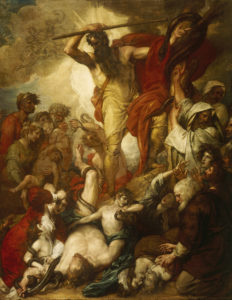Object of the Month: May 2021
The Brazen Serpent
Oil on canvas, 1790
Benjamin West, P.R.A.
American, active in England, 1738–1820
Roughly three years before the treaty ending the Revolutionary War, King George III commissioned Benjamin West to create a special series of paintings for the chapel at Windsor Castle. West, who had become one of the leading artists in England and Historical Painter to the King in 1772, considered this commission to be the “great work of [his] life.” The Progress of Revealed Religion would cover Biblical history from “commencement to completion.” To understand more about this royal commission, the artist, and M&G’s distinction of displaying the largest assembly of completed paintings from the series, read St. Peter Preaching at Pentecost.
West’s choices for the series’ subjects and organization were probably influenced by William Warburton, who wrote about the parallels between the Old and New Testaments and specifically how the Old Testament laid the foundation for the New Testament work of the Messiah, Jesus Christ. The artist chose and outlined his visual narratives for the chapel into four dispensations: creation and fall of man (pre-Mosaic law), the Israelite nation under Mosaic law, Christ’s life and dispensation of grace, and the last judgment.
M&G’s The Brazen Serpent fits within the dispensation focused on the Israelite nation under Mosaic law. The life of Moses is remarkable from birth to death. God called him to lead the enslaved Hebrew nation out of Egypt to Canaan, the Promised Land. From the outset, the journey was challenging. As the Hebrews arrived at the Red Sea, their Egyptian masters followed them, and the situation looked dire. The overwhelmed children of Israel responded by crying, blaming God and Moses, and complaining about their circumstances—a cycle of responses that the infant nation would repeat. God miraculously parted the waters into two heaps while the large caravan crossed on dry land to the other side. As the Egyptians started through the waters, God closed the path with the Red Sea crashing down and destroying them instead—the first of His many provisions and blessings. God’s presence and leading were visible with a pillar of clouds by day and fire by night. He supplied fresh water, manna (bread of heaven), victory over enemies, clothing and shoes that didn’t wear out. On Mt. Sinai, God gave the Ten Commandments to Moses for the help of Israel’s development as a distinctive nation protected by God. God outlined unique worship features and a sanctuary designed for praise, prayer, and offerings to Jehovah alone. He chose this people and made a special covenant with them.
Even with these physical and spiritual blessings, the Israelites griped about the food (wishing for leeks and onions of Egypt, meat, etc.), their thirst for water, Moses’ leadership, fear of the “giants” in the land God promised them. Their recurring lack of gratitude led to judgment, including the curse to wander in the wilderness for 40 years, until the complaining generation (with the exception of Joshua and Caleb) had all died. Only their children would enter the land of promise. Following a victory over the Canaanites as they neared the border of the Promised Land, once again “the people spoke against God and Moses, ‘Why have you brought us up out of Egypt to die in the wilderness? For there is no food and no water, and our soul loathes this worthless bread.’ So the Lord sent fiery serpents among the people, and they bit the people; and many of the people of Israel died” (Numbers 21:4-9).
As on previous occasions, the people begged Moses to pray to God for their forgiveness, admitting they had sinned against the Lord and him. Moses prayed, and the Lord commanded him to “Make a fiery serpent, and set it on a pole; and it shall be that everyone who is bitten, when he looks at it, shall live. So, Moses made a bronze serpent, and put it on a pole.” Instead of taking away the punishment, God mercifully provided a remedy in the form of a brass serpent. Whoever turned to view the brazen serpent was healed. Individuals could make their choice: they could look and live or choose death.
Helmut van Erffa and Alan Staley consider The Brazen Serpent to be “one of the most successful full-scale paintings for the chapel.” In West’s powerful visual narrative, he included snakes everywhere—biting and coiling themselves around the people, and even some in the air (upper left). West owned a collection of Renaissance and Baroque engravings, which he often referenced for inspiration. The drama of this work borrows from both Peter Paul Rubens’ Brazen Serpent and the famous sculpture from antiquity of Laocoön and his sons (figure group at the lower left of the painting). However, the figure of Moses reflects the muscular strength and monumentality of Michelangelo’s style.
In the distance between Moses’ feet, the camp tents are barely visible, but filling the foreground (and our ears’ imagination) are a variety of emotional responses expressed by these suffering people. Compassionate, fearful mothers carry their children to view the bronze serpent. Some men are praying or pointing the way for others to look and be healed. Others are in the stages of recovery, while a few mourn over those who have died. West’s composition leads the eyes upward to the light breaking from heaven and silhouetting the figure of Moses—the brightest part of the painting, where there is hope, the cure.
Centuries after the great patriarch’s death, Nicodemus, a knowledgeable teacher of the Jewish Sanhedrin, came to Jesus by night for answers. To illustrate how one can enter God’s kingdom, Christ explained His coming crucifixion and hope of salvation, “And as Moses lifted up the serpent in the wilderness, even so must the Son of Man be lifted up, that whoever believes in Him should not perish but have eternal life” (John 3:14-15).
Erin R. Jones, Executive Director
Published 2021
